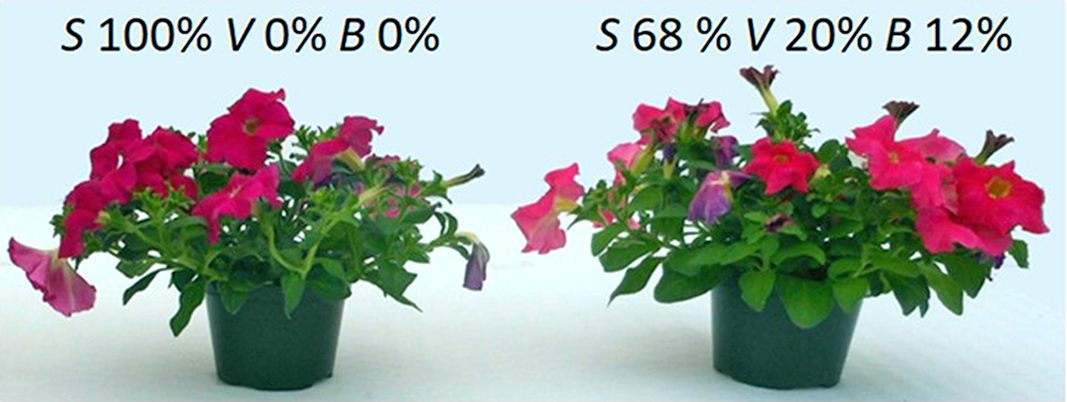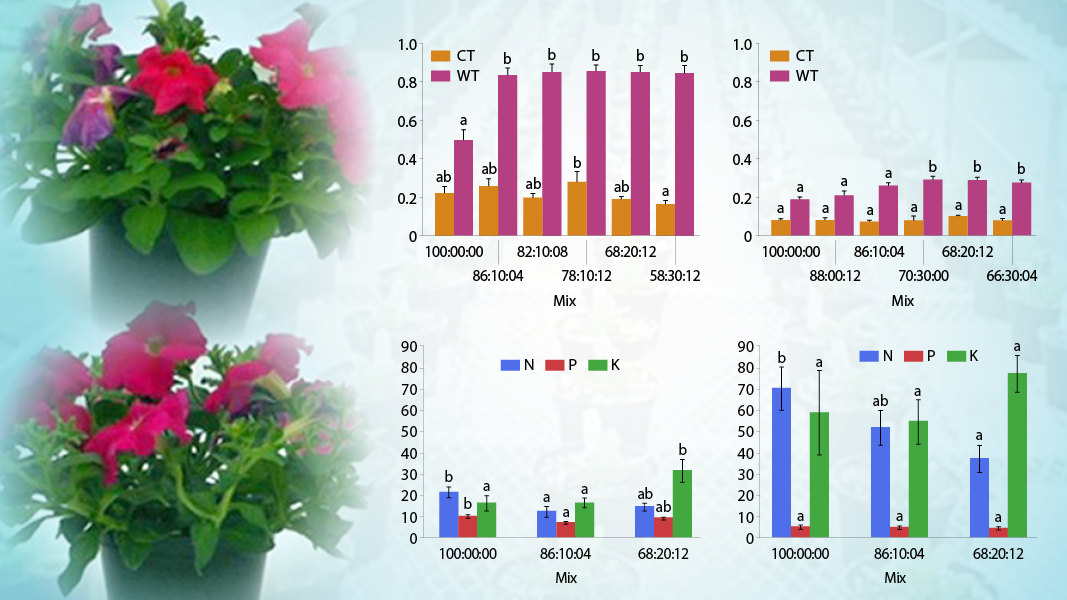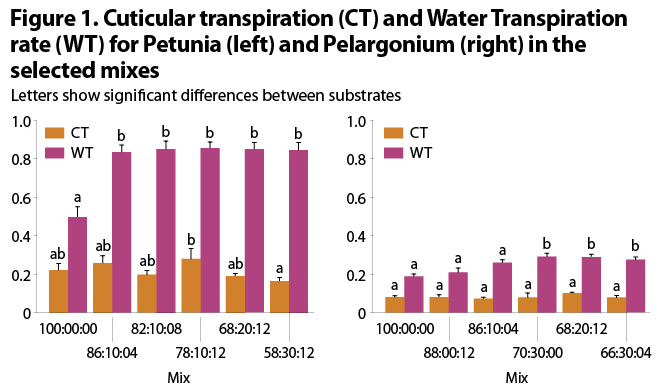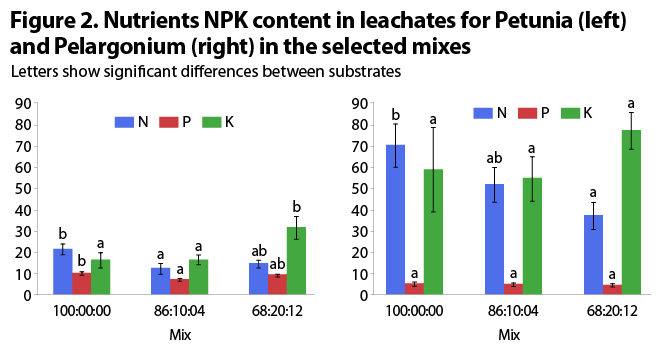José M. Álvarez de la Puente
The author conducted three different comparative greenhouse studies to assess the suitability of biochar (B) and vermicompost (V) as partial substitutes for peat-based growing media for ornamental plant production. Vermicompost was chosen because of its nutrient quality and lack of heavy metals. The first study (Part I) focused on the possibility of growing commercial quality containerized ornamental bedding plants (e.g., petunia and geranium) using 23 different biochar/vermicompost mixes as compared to a control of only peat in the substrate.
In the second study, the five best performing growing media from the first experiment were selected and the physiological plant responses when growing those species with the selected mixtures were verified. In the final study, leachates from the containers were analyzed to verify if fewer nutrients were lost by irrigation when growing those species with the selected mixes. Results of the latter two studies are discussed in this article. Details on the vermicompost and biochar used in all 3 studies is in Part I.

Petunia plant grown in container with a peat based substrate (left) and with a mixture of 20% vermicompost and 12% biochar (right).
Physiological Plant Responses
Materials and Mixes: The second experiment was designed to test the hypothesis that it is possible to produce plants of petunia (Petunia hybrida) and geranium (Pelargonium peltatum) with similar/better physiological characteristics while reducing the use of substrates from non-renewable sources (Alvarez et al., 2019a). The same biochar and vermicompost were used as in the first experiment. Five treatments plus a control were selected for each species (Table 1) because of their good results from the previous experiment. Three of those mixes were shared in both plant’s species.
Design: Like the first experiment, a random 5-block design was used for each species. The total number of plants was 2 sets x 2 species x 6 treatments x 5 blocks = 120 containers. Seedlings were produced on a plastic germination tray and then transferred to plastic containers and placed on benches in a greenhouse. Growing period was 20 weeks for Petunia, and 24 weeks for Pelargonium.
Measurements: In addition to the same parameters measured in the first experiment (e.g., chemical properties, nutrient concentration, plant growth), the second also measured four physiological parameters that serve to predict the future adaptability of the plant after transplanting it into the soil: Cuticular Transpiration (CT) Quisenberry et al. (1982); Root Growth Capacity (RGC) Ritchie (1985); Relative Conductivity of freeze-induced electrolyte (RC) as Landis (2010) and Burr (2001); and Water transpiration rate (WT) taking into account the transpiring water during a full day.
Results: Plant size and flower production improved when peat-based substrate was substituted with vermicompost and biochar at volume fraction rates of ≤ 12% of biochar and ≤ 30% vermicompost. Cuticular transpiration results in both species were not statistically significant. Physiological response due to the inclusion of vermicompost and biochar in the substrate mixture regarding CT and WT parameters was not detrimental to plants and in the event that the plants suffer from a short period of water stress, plants grown on the new substrates will not decrease their capacity to conserve water (Figure 1).
Root growth capacity and damage index of freeze inducted electrolyte leakage at -6.7 °C results in both species were not statistically significant. Thus physiological differences due to the inclusion of vermicompost and biochar were not shown by those two species in our experiments.
Conclusions: It is possible to grow containerized Petunia hybrida and Pelargonium peltatum plants with commercial quality after 3 or 4 months of cultivation, using substrates comprising a peat-based substrate mixed with biochar and/or vermicompost using at least 42% volume between both. Petunia and Pelargonium growth in these substrates showed that plants will be able to adapt themselves, at least similarly well as the plants grown in peat-based growing media, to the new environment after transplanting to garden soil.
Leachate Of Nutrients
The third experiment was designed to test the hypothesis that it is possible to produce plants of petunia (Petunia hybrida) and geranium (Pelargonium peltatum) generating less leachate of nutrients when including biochar and vermicompost as peat-based growing media partial substitutes (Alvarez et al., 2019).
Materials and Mixes: This experiment used the same biochar and vermicompost as the first two. Three growing media (mixes) were prepared with the following volume fractions (Peat based substrate:Vermicompost:Biochar): 100-00-00, 86-10-04 and 68-20-12 — respectively, the control treatment and two treatments containing a slight and a moderate peat-based substrate replacement. The last two treatments were selected based on the first study.
Design: A random 5 blocks design for each species: 5 leachate samples of common treatments in both species, 2 species x 5 days x 3 treatments x 5 blocks = 150 samples. Like in the first and second experiments, seedlings were produced on a plastic germination tray and then transferred to plastic containers and placed on tables in a greenhouse. Growing period was 8 weeks for Petunia, and 11 weeks for Pelargonium.
Measurements: Soluble nutrients, pH and electric conductivity (EC) in aqueous extracts (1:6 volume fraction) taken from fresh mixtures samples in advance of plant cultivation were measured as follows:
- EC and pH by a pH-meter/conductimeter (Acumet® Ap85, USA) (Ansorena Miner, 1994)
- Nitrate and ammonium by spectrophotometry in a flow autoanalyser (AA III, Bran + Luebbe, Norderstedt, Germany) (Ansorena Miner, 1994)
- Potassium, sulphate and phosphate by ICP-OES (Dahlquist & Knoll, 1978)
Results: With regard to nutrient concentrations, the fact is that nitrogen (N) concentration in leachates significantly decreased for both species as the amount of vermicompost and biochar increased. N content in leachates significantly decreased for both species as vermicompost and biochar increased. This could be due to nitrate that was retained due to the biochar-vermicompost mixture and was released more slowly.
The increase of potassium concentration in leachates (and content for Petunia) as the ratio of biochar applied to the mixtures increased. This could be a significant source of potassium in growing media mixtures and should be accounted for in fertility programs (Figure 2).
Overall Conclusions
Conclusions from all three studies are summarized:
- First experiment: It is possible to grow petunia and geranium containerized ornamental bedding plants with commercial quality using different biochar/vermicompost mixes. It will be possible to store up to 88.74 grams of CO2e per 800 ml container for long periods of time, first in the plant’s growing container and then in the soil after transplanting.
- Second experiment: Petunia and Pelargonium grown in best performing biochar/vermicompost substrate mixes showed a similar or better physiological response than plants grown in a control commercial peat-based substrate.
- Third experiment: Reduction in leachate’s nitrates concentration and content by biochar/vermicompost inclusion was found. Biochar addition may be a potassium fertilizer source.
These results, obtained with different biochar and vermicompost blends, are of interest to those who want to reduce peat consumption for the production of ornamental plants in containers; reduce carbon footprint: and reduce nitrate leachates of this commercially productive sector.
What can we say about maximum carbon (C) storage if this kind of peat replacement would be broadly disseminated? Consider that every year 11 million Mg (metric tons) of peat are consumed in horticulture. If 50% of worldwide peat used in horticulture would be in floriculture, and 20% of worldwide peat used in horticulture would be in container production, about a million Mg CO2e of potential C storage per year could be achieved if this container productive sector substituted peat-based growing media with a mix of 20% vermicompost and 12% biochar.
José M. Álvarez de la Puente is an independent scientific advisor and has been a BioCycle contributor on urban and agroindustrial compost. He holds a PhD in Industrial and Environmental Science and Technology from the University of Huelva, Spain. His PhD dissertation was defended in June 2019 at the Carbon Sequestration and Management Center of the Ohio State University as a visiting scholar.















